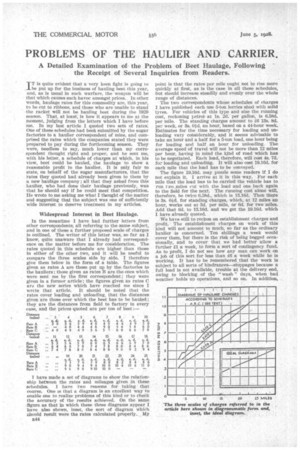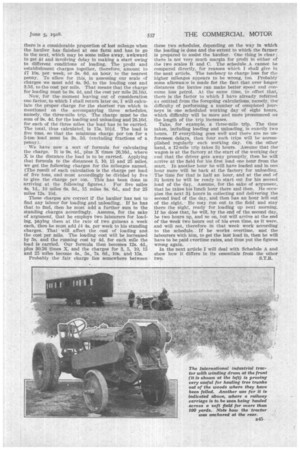PROBLEMS OF THE HAULIER AND CARRIER.
Page 70

Page 71

If you've noticed an error in this article please click here to report it so we can fix it.
A Detailed Examination of the Problem of Beet Haulage, Following the Receipt of Several Inquiries from Readers.
IT is quite evident that a very keen fight is going 10 be put up for the business of hauling beet this year, and, as is usual in such warfare, the weapon will be that which causes such havoc amongst prices. In other, words, haulage rates for this commodity are, this year, to be cut to ribbons, and those who are unable to stand the racket will not be hauling beet during the 1929 season. That, at least; is how it appears to me at the moment, judging from the letters which I have before me. In my last article I quoted two sets of rates. One of these schedules had beeh submitted-by the sugar factories to a haulier correspondent of mine, and comprised the rates which the companies stated they were prepared to pay during the forthcoming season. They were, needless to say, much lower than my correspondent thought right and proper, and he sent me, with his letter, a schedule of charges at which, in his view, beet could be hauled, the haulage to show a reasonable profit to the haulier. It is only fair to state, on behalf of the sugar manufacturers, that the rates they quoted had already been given to them by a new haulage company; all that they asked from this haulier, who had done their haulage previously, was that he should say if he could meet that competition. He wrote to me asking me what I thought of the matter and suggesting that the subject was one of sufficiently wide interest to deserve treatment in my articles.
Widespread Interest in Beet Haulage.
In the meantime I have had further letters from other correspondents; all referring to the same subject, and in one of these a further proposed scale of charges is outlined. The writer of this letter was, so far as I know, quite unaware that I already had correspondence on the matter before me for consideration. The rates quoted in this schedule are higher than those in either of the other two, and it will be useful to compare the three scales side by side. I therefore give them below in the form of a table. The figures given as rates A are those put up by the -factories to the hauliers; those given as rates B are the ones which were sent me by the first correspondent ; they were given in a former article; the figures given as rates C are the new series which have reached me since wrcte that article. It should be noted that the rates cover loading and unloading, that the distances given are those over which the beet has to be hauled ; they are the distances from field to factory in every case, and the prices quoted are per ton of beet :— Didance T have made a set of diagrams to show the relationship between the rates and mileages given in these schedules. I have two reasons for taking that course. One is that a diagram is an excellent way to enable one to realize problems of this kind or to check the accuracy of the results achieved. On the same figure as that in which these three diagrams appear I have also shown, inset, the sort of diagram which should result were the rates calculated properly. My 544 point is that the rates per mile ought not to rise more quickly at first, as is the case in all these schedules, but should increase steadily and evenly over the whole range of distances.
The two correspondents whose schedules of charges I have published each use 5-ton lorries shod with solid tyres. For vehicles of this type and size the running cost, reckoning petrol at 1s. 2d. per gallon, is 6.5&L per mile. The standing charges amount to £6 13s. 8d. per week, or 3s. bid. an hour, based on a 44-hour week. Estimates for the time necessary for loading and unloading vary considerably, and it seems advisable to take an hour and a half for a 5-ton load, one hour being for loading and half an hour for unloading. The average speed of travel will not be more than 12 miles per hour, having in mind the kind of road which has to be negotiated. Each load, therefore, will cost 4s. 7d. for loading and unloading. It will also cost 19.16d. for each mile that the load has to be conveyed.
The figure 19.16d. may puzzle some readers if I do not explain it. I arrive at it in this way. I'or each mile that the load has to be carried the vehicle has to run tyro, miles en!, with the load and one back again to the field for the next. The running cost alone will, therefore, be twice 6.58d., which is 13.16d. Then there Is 3s. Old. for standing charges, which, at 12 miles an hour, works out at 3d. per mile, or 6d. for two miles. Add that 6d. to 13.16d. and we get the 19.16d. which I have already quoted.
We have still to reckon on establishment charges and profit. The establishment charges on work of this kind will not amount to much, so far as the ordinary haulier is concerned. Ten shillings a week would cover them, but there is the risk of being bogged occasionally, and to cover that we had better allow a further 11 a week, to form a sort of contingency fund. As to profit, I do not see how any man can work on a job of this sort for less than £6 a week while he is working. It has to be remembered that the work is subject to all sorts of hindrances—stoppages because a full load is not available, trouble at the delivery end, owing to blocking of the " wash " days, when bad weather holds up operations, and so on. In addition,
there is a considerable proportion of lost mileage when the haulier has finished at one farm and has to go to the next, which may be some miles away, awkward to get at and involving delay in making a start owing to different conditions of loading. The profit and establishment charges together, therefore, amount to £7 10s. per week, or 3s. 6th an hour, to the nearest penny. To allow for this, in assessing our scale of charges we must add 4s, 9d. to the loading cost and 3.5d. to the cost per mile. That means that the charge for loading must be 9s. 4d. and the cost per mile 26.16d.
Now, for the moment leaving out of consideration one factor, to which I shall return later on, I will calculate the proper charge for the shortest run which is mentioned on the accompanying three schedules, namely, the three-mile trip. The charge must be the sum of 9s. 4th for the loading and unloading and 26.16d. for each of the three miles the load has to be carried. The total, thus calculated, is 15s. 10i.d. The load is five tons, so that the minimum charge per ton for a 5-ton load must be 3s. 3d. (excluding fractions of a penny).
• We have now a sort of formula for calculating the charge. It is 9s. 4d., plus X times 26.16d., where X is the distance the load is to be carried. Applying that formula to the distances 5, 10, 15 and 25 miles, we get the following charges for the mileages named. (The result of each calculation is the charge per load 1
of five tons, and must accordingly be divided by five to give the charge per ton. This has been done in arriving at the following figures.) For five miles 4s. id., 10 miles Os. 3d., 15 miles 8s. 6d., and for 25 miles 12s. 10d.
These charges are correct if the haulier has not to • find any labour for loading and unloading. If he has that to find, then he must add a further sum to the standing charges accordingly. Assume, for the sake of argument, that he employs two labourers for loading, paying them at the rate of two guineas a week each, then he must add £4 4s. per week to his standing charges. That will affect the cost of loading and the cost per mile. The loading cost will be increased by 3s. and the running cost by 441. for each mile the load is carried. Our formula then becomes 12s. 4d., plus 30.26 times X, and the charges for 3, 5, 10, 15 and 25 miles become 4s., 5s., 7s. 6c1., 10s. and 15s.
Probably the fair charge lies somewhere between 1
these two schedules, depending on the way in which the loading is done and the extent to which the farmer is prepared to assist the haulier. One thing is clear ; there is not very much margin for profit in either of the two scales B and C. The schedule A cannot be compared directly, for reasons which I shall give in the next article. The tendency to charge less for the higher mileages appears to be wrong, too. Probably some allowange is made for the fact that over longer distances the lorries can make better speed and consume less petrol. At the same time, to offset than' there is the factor to which I have already referred as omitted from the foregoing calculations, namely, the difficulty of performing a number of completed journeys in one scheduled working day of eight hours, which difficulty will be more and more pronounced as the length of the trip increases.
Take, for example, a three-mile_ trip. The time taken, including loading and unloading, is exactly two hours. If everything goes well and there are no unforeseen delays, then four such trips will be accomplished regularly each working day. On the other hand, a 12-mile trip takes 3i hours. Assume that the wagon is at the factory at the start of the working day end that the driver gets away promptly, then he will arrive at the field for his first load one hour from the start. In another hour he will have loaded and in one tour more will be back at the factory for unloading. The time for that is half an hour, and at the end [-If 3i hours he will be ready to start out for his second cad of the day. Assume, for the sake of argument, that he takes his lunch hour there and then. Be occupies the next 3i hours in collecting and delivering the second load of the day, and then has an hour left out of the eight. He may run ont to the field, and stay there the night, ready for loading up next morning. If he does that, he will, by the end of the second day, be two hours up, and so on, but will arrive at the end of the week two hours out of his even time, as it were, and will not, therefore in that week Work according to the schedule. If be works overtime, and the labourers with him, to get the last load in, then he will have to be paid cvertime rates, and thus put the figures wrong again.
In the next article I will deal with Schedule A and show how it differs in its essentials from the other two. S.T.R.




















































































































